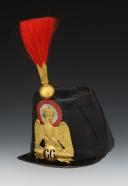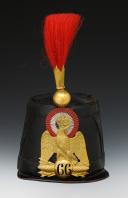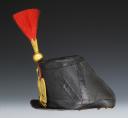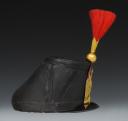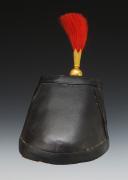
OFFICER'S SHAKO OF THE 66th LINE INFANTRY REGIMENT, Grenadier model 1860, Second Empire, 29553R
Sold out
OFFICER'S SHAKO OF THE 66th LINE INFANTRY REGIMENT, Grenadier model 1860, Second Empire, 29553R
Made of black waxed leather, reinforced frame in the upper part with a leather band (width 1.5 cm), an identical boudalou (width 2.3 cm), and on each side two leather bands (width 2 cm) sewn in a V shape with a black lacquered metal ventilator in the center at the top. Black waxed leather visor, green waxed interior, width 3 cm.
Brass plate with the stamped crowned imperial eagle, placed on a cut globe with the number "66" and a sparkling Jupiter's spindle, Height 11 cm, width 9.5 cm. Tricolor lacquered metal cockade, diameter 5.3 cm.
Interior cap in black leather gilt on its outer edge and scarlet silk with a crown lined with scarlet waxed calf stamped with gilt iron.
Shako height at the front 12.5 cm, at the back 19 cm.
Scarlet plume with a gilt brass tulip-shaped olive pom-pom.
France.
Second Empire (1860-1870).
Fair condition, green holes and small leather losses on the exterior, minor damages on the crown, interior cap worn with torn silk and some missing parts.
HISTORICAL BACKGROUND:
66th infantry regiment under the Second Empire.
It was garrisoned in the following cities until 1863: Bar-le-Duc, Verdun, Châlons-sur-Marne camp, and finally in Strasbourg.
1853: the regiment is not listed in the regiments of the Crimean War. But it sent 1,000 volunteers there.
1854: called to Paris.
1855: part of the Northern army in Boulogne under the command of Mac Mahon.
1856: reorganized into three battalions.
1859: back to four battalions.
By decree of May 2, 1859, the 66th infantry regiment provided a company to form the 102nd line infantry regiment.
1863: sent back to Algeria as part of a pacification campaign.
1865: Battle of Takitount.
1866: intervention in Tunisia at Aïn Béïda and Tébessa (now in Algeria).
1867: the regiment returned to France and was garrisoned in Antibes.
1870 War
During the 1870 war, there were two infantry units bearing the number 66. Firstly, the 66th "line" regiment composed of career soldiers, which is the unit described in this article since its creation. And secondly, a new unit, the 66th "march" regiment composed of conscripts from Touraine, created following Léon Gambetta's appeal within the government of National Defense to constitute a relief army known as the "Loire army." The objective of this army was to rebuild the defense of the territory following the collapse of the regular army.
The 66th line infantry regiment (Army of the Rhine)
The regiment, along with the 67th line infantry regiment, formed the 2nd infantry brigade commanded by General Jacques Alexandre Jules Fauvart-Bastoult. This brigade was part of the 2nd division of General Bataille of the 2nd corps of General Frossard.
Battle of Saarbrücken on August 2, 1870.
Battle of Forbach-Spicheren on August 6, 1870.
Battle of Mars-la-Tour, where the regiment fought near Gorze on August 16 and 18, 1870.
Siege of Metz (1870) from August 20 to October 27, 1870. During the surrender, the regiment was taken captive in its entirety. Throughout this siege, it lost 34 officers and 1,333 men (killed and wounded).
On November 24, 1870, the marching companies of the 66th line infantry regiment, which formed the 44th marching regiment, were engaged in the battles of Chilleurs, Ladon, Boiscommun, Neuville-aux-Bois, and Maizières in Loiret.
The 66th march regiment (Loire army and Eastern army)
The regiment was created on December 11, 1870, in Tours under the command of Lieutenant Colonel Le Corbeiller. This regiment fought as part of the 2nd Loire army. It consisted of young conscripts from Touraine of the 1870 class. It was part of the 1st Loire infantry brigade, commanded by General Ritter. This brigade was part of the 1st Loire infantry division led by General (provisionally) Bardin and the 19th Loire army corps led by General Dargent.
On December 12, immediately after its creation, this new unit was sent to Cherbourg, where it arrived on December 27. It barely fought against the Prussians, retreating like the rest of the Loire army in the extreme harsh winter of 1870 and facing food shortages. However, it participated, along with the men of the 88th mobile guard regiment, in the last battles of the war at Saint-Melaine on January 18, 1871. The armistice was signed on January 28, 1871, and extended until March 12. In the meantime, the preliminary peace treaty was signed on February 26, 1871.
On January 9, 1871, the marching companies of the 66th line infantry regiment, forming the 44th march regiment, were engaged in the battle of Villersexel.
Made of black waxed leather, reinforced frame in the upper part with a leather band (width 1.5 cm), an identical boudalou (width 2.3 cm), and on each side two leather bands (width 2 cm) sewn in a V shape with a black lacquered metal ventilator in the center at the top. Black waxed leather visor, green waxed interior, width 3 cm.
Brass plate with the stamped crowned imperial eagle, placed on a cut globe with the number "66" and a sparkling Jupiter's spindle, Height 11 cm, width 9.5 cm. Tricolor lacquered metal cockade, diameter 5.3 cm.
Interior cap in black leather gilt on its outer edge and scarlet silk with a crown lined with scarlet waxed calf stamped with gilt iron.
Shako height at the front 12.5 cm, at the back 19 cm.
Scarlet plume with a gilt brass tulip-shaped olive pom-pom.
France.
Second Empire (1860-1870).
Fair condition, green holes and small leather losses on the exterior, minor damages on the crown, interior cap worn with torn silk and some missing parts.
HISTORICAL BACKGROUND:
66th infantry regiment under the Second Empire.
It was garrisoned in the following cities until 1863: Bar-le-Duc, Verdun, Châlons-sur-Marne camp, and finally in Strasbourg.
1853: the regiment is not listed in the regiments of the Crimean War. But it sent 1,000 volunteers there.
1854: called to Paris.
1855: part of the Northern army in Boulogne under the command of Mac Mahon.
1856: reorganized into three battalions.
1859: back to four battalions.
By decree of May 2, 1859, the 66th infantry regiment provided a company to form the 102nd line infantry regiment.
1863: sent back to Algeria as part of a pacification campaign.
1865: Battle of Takitount.
1866: intervention in Tunisia at Aïn Béïda and Tébessa (now in Algeria).
1867: the regiment returned to France and was garrisoned in Antibes.
1870 War
During the 1870 war, there were two infantry units bearing the number 66. Firstly, the 66th "line" regiment composed of career soldiers, which is the unit described in this article since its creation. And secondly, a new unit, the 66th "march" regiment composed of conscripts from Touraine, created following Léon Gambetta's appeal within the government of National Defense to constitute a relief army known as the "Loire army." The objective of this army was to rebuild the defense of the territory following the collapse of the regular army.
The 66th line infantry regiment (Army of the Rhine)
The regiment, along with the 67th line infantry regiment, formed the 2nd infantry brigade commanded by General Jacques Alexandre Jules Fauvart-Bastoult. This brigade was part of the 2nd division of General Bataille of the 2nd corps of General Frossard.
Battle of Saarbrücken on August 2, 1870.
Battle of Forbach-Spicheren on August 6, 1870.
Battle of Mars-la-Tour, where the regiment fought near Gorze on August 16 and 18, 1870.
Siege of Metz (1870) from August 20 to October 27, 1870. During the surrender, the regiment was taken captive in its entirety. Throughout this siege, it lost 34 officers and 1,333 men (killed and wounded).
On November 24, 1870, the marching companies of the 66th line infantry regiment, which formed the 44th marching regiment, were engaged in the battles of Chilleurs, Ladon, Boiscommun, Neuville-aux-Bois, and Maizières in Loiret.
The 66th march regiment (Loire army and Eastern army)
The regiment was created on December 11, 1870, in Tours under the command of Lieutenant Colonel Le Corbeiller. This regiment fought as part of the 2nd Loire army. It consisted of young conscripts from Touraine of the 1870 class. It was part of the 1st Loire infantry brigade, commanded by General Ritter. This brigade was part of the 1st Loire infantry division led by General (provisionally) Bardin and the 19th Loire army corps led by General Dargent.
On December 12, immediately after its creation, this new unit was sent to Cherbourg, where it arrived on December 27. It barely fought against the Prussians, retreating like the rest of the Loire army in the extreme harsh winter of 1870 and facing food shortages. However, it participated, along with the men of the 88th mobile guard regiment, in the last battles of the war at Saint-Melaine on January 18, 1871. The armistice was signed on January 28, 1871, and extended until March 12. In the meantime, the preliminary peace treaty was signed on February 26, 1871.
On January 9, 1871, the marching companies of the 66th line infantry regiment, forming the 44th march regiment, were engaged in the battle of Villersexel.
Reference :
29553R
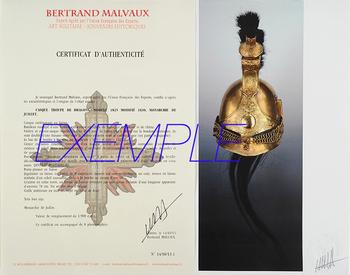
Next update Friday, april 4th at 1:30 PM
FOR ALL PURCHASES, PAYMENT IN MULTIPLE CHECKS POSSIBLE
bertrand.malvaux@wanadoo.fr 06 07 75 74 63
An authenticity certificate of the item including the description published on the site, the period, the sale price, accompanied by one or more color photographs is automatically provided for any item priced over 130 euros. Below this price, each certificate is charged 5 euros.
Only items sold by me are subject to an authenticity certificate, I do not provide any expert reports for items sold by third parties (colleagues or collectors).
